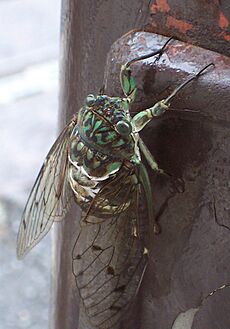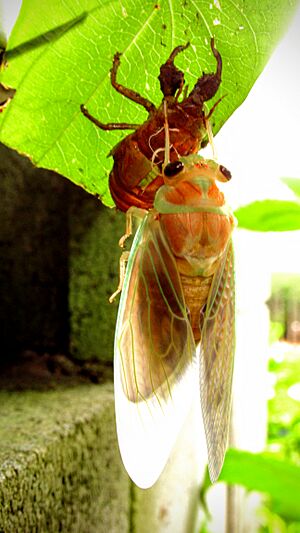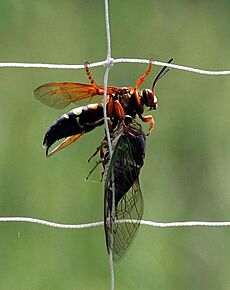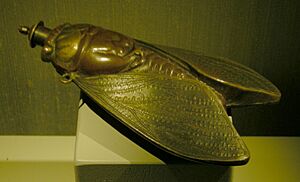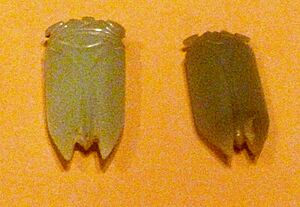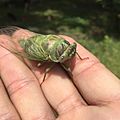Cicada facts for kids
Quick facts for kids Cicada |
|
|---|---|
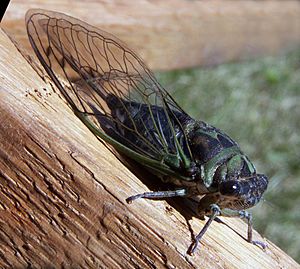 |
|
| Annual cicada, Neotibicen linnei | |
| Scientific classification |
|
| Kingdom: | Animalia |
| Phylum: | Arthropoda |
| Class: | Insecta |
| Order: | Hemiptera |
| Infraorder: | Cicadomorpha |
| Superfamily: | Cicadoidea Latreille, 1802 |
| Families | |
|
|
Cicadas are amazing insects known for their loud songs! They belong to a group called the Cicadoidea. These insects are related to smaller jumping bugs like leafhoppers and froghoppers. There are two main families of cicadas: the Tettigarctidae, which has only two species found in Australia, and the Cicadidae, which has over 3,000 species around the world. Many more species are still waiting to be discovered!
Cicadas have big eyes that are set far apart. They also have short antennae and clear, see-through front wings. Most cicadas make a super loud sound using special drum-like parts called tymbals. They make this sound by quickly bending and unbending these parts. The oldest cicada fossils are from the Upper Permian period, a very long time ago. Today, cicadas live all over the world in warm and hot places. They usually live in trees, where they drink watery sap from the tree's xylem. Females lay their eggs in a small cut they make in the tree bark. Most cicadas are good at hiding because they blend in with their surroundings. Most adult cicadas are active during the day, with some singing at dawn or dusk. Only a few types are active at night.
One special group of cicadas, called Magicicada (the periodical cicadas), lives only in North America. These cicadas spend most of their lives as young nymphs underground. They then come out of the ground all at once, either every 13 or 17 years! This long and synchronized emergence helps them survive. By coming out in huge numbers, they can feed all the predators (like birds) so that enough cicadas are left to keep their species going. Also, because they emerge so rarely, predators can't rely on them as a regular food source.
Annual cicadas are different. While their young also live underground for several years (from 1 to 9 years or more), they don't all emerge at the same time. This means you can see some of these cicadas every year.
Cicadas have been important in stories and art for a very long time. They appear in ancient Greek poems like Homer's Iliad and in Chinese art from the Shang Dynasty. People have used them as symbols of a carefree life and even immortality. In some parts of the world, like China, Myanmar, Malaysia, and central Africa, people even eat cicadas!
Contents
What Are Cicadas?
Amazing Insect Features
Cicadas are large insects that are easy to spot because of the loud songs the males sing. They have three joints in their feet and small antennae with a few segments. Cicadas are different from other bugs because their mouthparts come from the back of their head. They also have special membranes that make sound and a way to link their wings together.
Cicadas are not good at jumping, and young cicadas (nymphs) can't jump at all. Another special thing about them is how their front legs are built for digging underground. The Tettigarctidae family is different from the Cicadidae family because their front body part extends further back, and they don't have the same sound-making parts.
Adult cicadas are usually about 2 to 5 centimeters (1 to 2 inches) long. The biggest one, the empress cicada (Megapomponia imperatoria), can be about 7 centimeters (3 inches) long, with a wingspan of 18 to 20 centimeters (7 to 8 inches)! Cicadas have big compound eyes on the sides of their head. Their short antennae stick out between or in front of their eyes. They also have three small simple eyes on top of their head, which helps tell them apart from other bugs.
Their mouthparts form a long, sharp tube that they use to poke into plants and drink sap. The front of their head has a large, nose-like part that helps them pump the sap.
The middle part of their body, called the thorax, holds their strong wing muscles. They have two pairs of clear, cloudy, or colored wings. The patterns on their wings can help identify different species. The underside of their middle body part has a cover that can hide parts of their belly. The belly is segmented, and the last parts hold the reproductive organs. Females have a saw-edged part called an ovipositor for laying eggs. In males, the belly is mostly hollow and acts like a sound box to make their songs louder.
The surface of their front wings is super water-repellent. It's covered with tiny, waxy bumps that make water roll off, cleaning the wings. Even Bacteria that land on the wings are killed because the tiny spikes tear their membranes apart. This makes the cicada wing the first known natural material that can kill bacteria!
Staying Cool in the Heat
Desert cicadas, like Diceroprocta apache, are special because they can cool themselves down by evaporating water, just like mammals sweating. When they get too hot (above 39°C or 102°F), they drink extra sap from plants and push out the extra water through tiny holes in their skin. This helps them lower their body temperature by about 5°C (9°F). They can only do this by drinking a lot of watery sap. Other cicadas can also raise their body temperature by as much as 22°C (40°F) above the air temperature.
Amazing Cicada Sounds
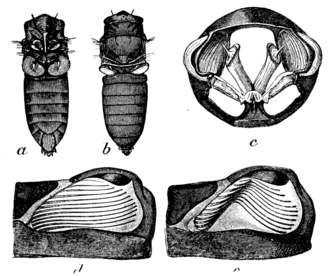
a, Body of male from below, showing cover-plates;
b, From above, showing drumlike tymbals;
c, Section, muscles that vibrate tymbals;
d, A tymbal at rest;
e, Thrown into vibration, as when singing
The male cicadas "sing" using special parts called tymbals. There's one on each side of their front belly area. Muscles pull these tymbals, making them buckle. Because they are made of a bouncy material, they quickly unbuckle when the muscles relax, creating the cicada's unique sound. Some cicadas also make sounds by rubbing their wings over ridges on their body. In a Chinese species called Subpsaltria yangi, both males and females can make sounds this way. The sounds can be changed by special covers and hollow spaces in their bodies.
The male's belly in some species is mostly hollow, acting like a sound box. By vibrating these membranes quickly, a cicada combines clicks into what sounds like a continuous note. Enlarged air tubes act as resonance chambers to make the sound louder. The cicada can also change its song by moving its belly closer to or further away from the surface it's on. Each species has its own special mating song and signals, which helps them attract only the right mates.
Most cicadas sing most actively during the hottest parts of a summer day. They usually depend on outside heat to warm them up. A few species are known to sing at dusk, and some are truly nocturnal (active at night), like Kanakia gigas and Froggattoides typicus.
Cicadas sing from different heights in trees. Where many species live together, they might use different heights and times to sing. While most cicadas sing above ground, two Californian species sing from hollows at the base of trees, below ground. This might help them avoid predation.
Even though only males sing, both male and female cicadas have special membranes called tympana that help them hear. These are like their ears. Males turn off their own hearing while singing to protect their ears, because some cicadas can make sounds as loud as 120 decibels! This is one of the loudest sounds made by any insect. The song is so loud that it can cause permanent hearing loss in humans if a cicada is too close. On the other hand, some small species have songs that are too high-pitched for humans to hear.
It can be hard for humans to tell exactly where a cicada's song is coming from. Their pitch is almost constant, and the sound seems continuous. Also, cicadas sing in scattered groups. Besides the mating song, many species have a special distress call, which is usually a broken and uneven sound they make when caught or scared. Some species also have quieter courtship songs, which they sing after a female has been attracted by the main song. Males also make "encounter calls" when courting or to keep their personal space in a group.
Scientists who study insects (entomologists) believe that each cicada species has a unique song. There are many resources that collect and analyze cicada sounds.
Cicada Life Cycle
In some cicada species, the males stay in one spot and sing to attract females. Sometimes, several males gather and sing together in a chorus. In other species, males move around, usually with quieter songs, while looking for females. After mating, the female cuts small slits into the bark of a twig and lays her eggs there. Both male and female cicadas die within a few weeks after they emerge from the soil. Even though they can drink some plant liquids for food, they don't eat much, and their adult life is usually less than two months long.
When the eggs hatch, the tiny new nymphs (young cicadas) drop to the ground and dig into the soil. Cicadas live underground as nymphs for most of their lives, sometimes as deep as 2.5 meters (8 feet). Nymphs have strong front legs for digging and making tunnels near plant roots, where they drink xylem sap. In wet areas, larger species build mud towers above ground to help air get into their burrows. When they are ready to become adults, they build an exit tunnel to the surface and come out. Then, they molt (shed their skin) on a nearby plant for the last time, and become adults. The empty skins, called exuviae, are often left clinging to tree bark.
Most cicadas have a life cycle that lasts 2 to 5 years. But some species have much longer life cycles, like the North American genus Magicicada. These periodical cicadas have different groups, called "broods," that emerge every 17 years or, in some areas, every 13 years. These long life cycles might have developed to avoid predators, like the cicada killer wasp and praying mantis. A predator with a shorter life cycle couldn't rely on cicadas as food. For example, a 17-year cicada would only face a peak predator population every 85 years (5 × 17) if the predator had a 5-year life cycle. Another idea is that these long life cycles developed during ice ages to help them survive cold periods. The 13- and 17-year cicadas only emerge in the same year in the midwestern and eastern US every 221 years (13 × 17). The year 2024 was the first time this happened since 1803!
What Cicadas Eat
Cicada nymphs drink sap from the xylem of various trees, including oak, cypress, willow, ash, and maple. While some people think adult cicadas don't eat, they actually do drink plant sap using their special mouthparts. Cicadas drink a lot of sap, so they often excrete fluid in streams of droplets.
How Cicadas Move
Cicadas are not built for jumping, unlike some other bugs in their group. They can walk and fly, but they don't walk or run very well. They usually fly if they need to travel more than a few centimeters.
Enemies and Defenses
Many animals eat cicadas, including birds, mammals, bats, wasps, mantises, spiders, and robber flies. When huge numbers of cicadas emerge, many animals change what they usually eat to take advantage of the easy food. Tiny new nymphs can be eaten by ants, and nymphs underground are hunted by digging mammals like moles. In northern Japan, brown bears dig up the ground to eat cicada nymphs in the summer. In Australia, the Australian cicada killer wasp (Exeirus lateritius) stings and stuns cicadas in trees, making them fall. The wasp then carries them to its burrow to feed its young.
Some cicadas get sick and die from fungal diseases. Other fungi attack the nymphs underground. One specific fungus, Massospora cicadina, attacks adult periodical cicadas. Its spores stay in the soil between outbreaks.
Plants can also protect themselves from cicadas. Even though cicadas can feed on the roots of cone-bearing trees, the resin from trees like pine can stop Magicicada eggs from hatching by sealing up the egg cavities.
How Cicadas Hide and Protect Themselves
Cicadas use different ways to avoid predators. Large cicadas can fly away quickly if disturbed. Many are very well camouflaged to hide from predators like birds that hunt by sight. They are colored like tree bark and have patterns that break up their shape, making them hard to see. Their partly clear wings are held close to their body and pressed against the tree. Some cicada species even play dead when they feel threatened.
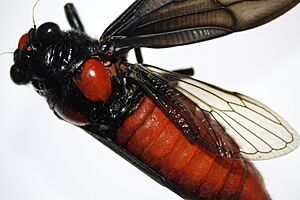
Some cicadas, like Hemisciera maculipennis, show bright, startling colors on their hind wings when threatened. This sudden flash helps to scare predators, giving the cicada time to escape. Most cicadas are active during the day and rely on camouflage when resting. But some species use warning colors to tell predators they might be toxic, even if they aren't. This is called Batesian mimicry. For example, the Malaysian Huechys sanguinea has bright red and black warning colors, is active during the day, and flies boldly in plain sight of predators.
Predators like the sarcophagid fly Emblemasoma hunt cicadas by sound, being attracted to their songs. Singing males might soften their song to distract a listener to louder singers nearby, or stop singing completely if a predator gets close.
Cicadas in Human Culture
In Art and Stories
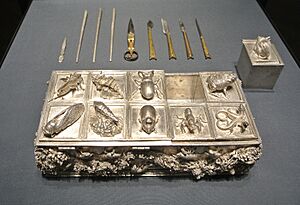
Cicadas have appeared in stories since ancient times, like Homer's Iliad. They have also been used as designs in art, such as from the Chinese Shang dynasty (1766–1122 BCE). The ancient Greek writer Aristotle and Roman writer Pliny the Elder both wrote about cicadas. In the famous 14th-century Chinese novel Romance of the Three Kingdoms, a character named Diaochan got her name from the cicada-shaped decorations on officials' hats.
In the Japanese novel The Tale of Genji, a character compares one of his love interests to a cicada because she gracefully sheds her robe, like a cicada shedding its skin. Cicada skins are also important in the manga Winter Cicada. Cicadas are often featured in Japanese poems called haiku, where they can represent spring, summer, or autumn. Shaun Tan's book Cicada tells the story of a hardworking cicada in an office. The play Appropriate by Branden Jacobs-Jenkins uses the sounds of mating cicadas throughout the show.
As Food and Medicine
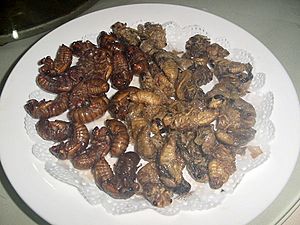
People in Ancient Greece ate cicadas, and today they are eaten in certain parts of China, usually as young nymphs. Cicadas are also eaten in Malaysia, Burma, North America, and central Africa. Female cicadas are often preferred because they are meatier. The empty shells of cicadas are used in traditional Chinese medicine. The 17-year Magicicada cicadas are culturally important and a special food for the Onondaga people. Modern people in some US states also see them as a unique food.
In Music
Cicadas are featured in the protest song "Como La Cigarra" ("Like the Cicada") by Argentinian artist María Elena Walsh. In this song, the cicada symbolizes survival and not giving up. The song has been recorded by many Latin American musicians.
In North America and Mexico, there's a well-known Mariachi song called "La Cigarra" ("The Cicada"). It romanticizes the insect as a creature that sings until it dies.
Brazilian artist Lenine used the sound of cicadas in his song "Malvadeza" from the album Chão.
Cicada sounds are a big part of the 2021 album Solar Power by New Zealand artist Lorde. She said that cicada songs represent the New Zealand summer to her.
In Myths and Stories
Cicadas have been used as money, in folk medicine, to predict weather, and to provide music (in China). They appear in myths and stories all over the world. In France, the cicada represents the culture of Provence and Mediterranean cities.
Since ancient times, the cicada has symbolized a carefree attitude. Jean de La Fontaine started his collection of fables with "The Cicada and the Ant," based on one of Aesop's fables. In this story, the cicada spends the summer singing, while the ant stores food. When winter comes, the cicada has no food.
In Chinese tradition, the cicada (蟬, chán) symbolizes rebirth and immortality. In the Chinese essay "Thirty-Six Stratagems", the phrase "to shed the golden cicada skin" means to use a decoy (like leaving the empty cicada skin) to trick enemies. In the Chinese classic novel Journey to the West, the main character, the Priest of Tang, was named the Golden Cicada.
In Japan, the cicada is linked to the summer season. For many Japanese people, summer hasn't truly begun until they hear the first cicada songs. The song of Meimuna opalifera, called tsuku-tsuku boshi, is said to signal the end of summer.
In ancient Greek myths, the goddess Aphrodite tells a story about how Eos, the goddess of dawn, asked Zeus to let her lover Tithonus live forever. Zeus said yes, but Eos forgot to ask him to also make Tithonus stay young. So, Tithonus never died, but he grew very old and tiny, eventually turning into the first cicada. The Greeks also used a cicada sitting on a harp as a symbol of music.
In Kapampangan mythology in the Philippines, the goddess of dusk, Sisilim, is said to be greeted by the sounds and appearances of cicadas whenever she appears.
Are Cicadas Pests?
Cicadas drink sap. They don't bite or sting people, but they might sometimes mistake a person's arm for a plant branch and try to feed. Male cicadas make very loud calls that can harm human hearing if you are too close.
Cicadas are not usually a big problem for farms. However, in years when huge numbers of cicadas emerge, trees can be overwhelmed by the many females laying their eggs in the branches. Small trees might wilt, and larger trees might lose small branches. While the feeding of young nymphs usually doesn't cause much damage, during the year before a big emergence of periodical cicadas, the large nymphs feed a lot, and plant growth might suffer. Some cicadas have started feeding on sugarcane, which can harm the crop. In a few rare cases, females have laid eggs on valuable crops like date palms, grape vines, citrus trees, asparagus, and cotton.
Cicadas can sometimes damage ornamental shrubs and trees. This mainly happens when females leave scars on branches where they lay their eggs. Branches of young trees might die because of this.
Images for kids
-
Cicada clinging to the bark of an eastern red cedar tree in Oklahoma


